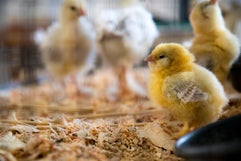VETKO | News
8-10 march VIV-ASIA 2023 in Bangkok
GMP+ Certification obtained

Since 15 May 2020, VETKO has obtained the GMP+ Certification under the GMP+ number: GMP052443. We are proud of having obtained this GMP+ Feed Safety Assurance certificate. As a company producing quality Nutritional products, we want to be a responsible partner in feed and food safety. We want to be part of a responsible food chain for today’s and future generations. Food safety starts with improving feed safety and this includes that all processes and ingredients need to be continuously monitored, evaluated, revised, and improved. To assure transparency in all these processes, GMP+ plays an essential role.
From healthy chick to healthy chicken
Tips for healthy poultry growth


One of the most important things to do while raising chickens is to provide a stable natural environment for them to live in and grow. If you’re currently raising or considering raising chickens, there are several things you can do to make your venture successful.
Whether you’re raising chickens as a commercial venture or to supplement your home pantry, raising healthy birds is a worthwhile investment of time and effort. Regardless of your reason for buying hens and roosters, their diet and the environment will both impact their health.
Raising healthy poultry
Raising healthy poultry serves many purposes. Happy chickens living in a stress-free environment produce larger eggs, and higher quality meat, when compared to chickens living in overcrowded coops.
Select the right breed
Research is a key factor here. Are you getting chickens so that you can have a large supply of eggs, are you looking for chickens that will produce a large amount of meat, or both?
If you’re looking for a large volume of eggs, we recommend the Golden Comet breed. They’re relatively calm, can be raised near other animals, and lay between 250 and 300 eggs a year.
For a meat-producing bird, we like the Buckeye breed because they’re resilient! They’re designed for the cold, but can thrive in most environments, and they’re disease resistant. They weigh about nine pounds when they’re grown, and they have a beautiful color as well.
Our favorite dual-purpose chicken is the Black Australorp. Males weigh between 8.5 and 10 lbs, and females are between 6.5 and 8.0 lbs. This breed also lays an average of 250 eggs a year, which is pretty incredible. Although they may be a little shy at first and do well in a coop, you should allow them some space to roam so they can forage for bugs and other critters.
Maintain the coop
This may seem like a no brainer, but you’ll want to keep the water source clean, fresh, and change the water daily. Provide a safe coop with adequate lighting. Having a safe, indoor space is essential for your birds, and consider adding a small heating unit for the winter.
Also, regularly check your coop for any signs of damage or any loose areas of the fencing; this will help protect your flock from predators. Keeping your birds in an enclosed pen protects them from coyotes, stray dogs, foxes, and other animals.
Protect the flock against disease
Similarly to a house pet, you’ll want to make sure that you’re vaccinating your chickens against disease. Control insect and parasite infestations., this goes hand-in-hand with cleanliness and vaccinations.
Invest in quality feed
Maintain a good food source. Consider adding calcium and mineral-rich additives such as oyster shell grit or diatomaceous earth to grains. This will not only enrich the diet of the chickens, but added calcium will also help produce strong eggs.
Commonly made mistakes
Although a lot of us have been raising poultry for some time, there may be some people who are just getting into raising roosters and hens. Here’s a list of the five things we wish we were told when we started raising our flock.
The golden ratio
Depending on the breed, the ratio of hens to roosters is going to vary, but we recommend a 12:1 ratio, so for every 12 hens, you should have 1 rooster. If you have too many roosters, then your hens will be mated too often, and they end up missing feathers, having bear backs, and can even be injured.
Not taking inventory of your flock
When we first started raising chickens, we let them roam around during the day and coaxed them back into the coop at night. However, we weren’t counting how many were there. This leads to multiple chickens 'disappearin' over time.
by Zoe Morrison

